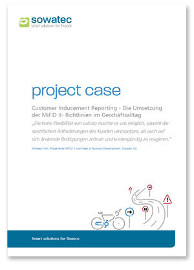A real-life example
-
The challenge
Until now, our customer, a Swiss financial institution, had no central system that could collate, calculate and report the fees of their many investment products at a customer level.
Each business and product department was familiar primarily with their own offering and charges.
To translate the MiFID II customer reporting requirements into a simple and efficient process, our customer was looking for a central and automated system-solution to calculate third-party inducements and manage associated customer reporting.
-
Our objective
To create a single calculation system that replaces manual and semi-automated processes and to create customer reports that contain all relevant information.
-
Our solution
We created a calculo-based software solution that automates the calculation of third-party inducements for each of the investment products. In addition, it centralises the data preparation for customer reporting.
calculo is a software solution based on Business Rules Management (BRM) technology. It imports
master and transaction data via configurable interfaces. Data imports, calculation and reporting processes are largely automated.

In conversation
Andreas Hütt, MiFID II Project Manager and Head of Business Development at Sowatec AG, on rolling out a calculo solution for a prominent global bank.
What challenges did the EU Markets in Financial Instruments Directive (MiFID II) create for the bank that lead to this project?
MiFID II requires financial institutions to disclose those inducements to customers that are received on the customer’s investments [or: deposits]. As part of a larger programme to implement MiFID II requirements, the calculo project was brought into existence specifically to create transparency around inducements (commissions from third parties).
How had inducements been treated so far?
Until then there were no legal requirements to summarise and report third-party inducements at a customer level. Each product area could thus calculate and handle third-party fees independently from each other.
With what hurdles was the project faced during implementation, and how were these overcome?
One challenge was that MiFID II requirements were only in draft form when the project started. The transcription into national law had not yet occurred. The project requirements thus relied to a large part on interpretations and working hypotheses. These were substantiated and refined in the course of the project. Flexible project planning involving six software releases allowed iterative implementation of the necessary revisions.
Also, some of the source data required for the calculation was supplied in significantly greater volumes than expected. In some instances, data volumes ten times larger than anticipated had to be processed. calculo’s open interface architecture however made it possible to conduct [two-stage] pre-processing and performance optimisations without having to discard the original interfaces.
What in your opinion were the key factors for success?
The close cooperation between Sowatec and the Swiss bank on the project management and architecture level, as well as the great flexibility of calculo. These made it possible for us to realise the customer‘s requirements and to respond to changing regulatory stipulations in a timely and cost-effective manner.
Learn more about calculo
Our customers need flexible and powerful solutions in response to the complexity of regulatory challenges and complience requirements. Sowatec’s software solution calculo is modular and meets the sophisticated needs of all our customers.
Learn more about calculo
Our customers need flexible and powerful solutions in response to the complexity of regulatory challenges and complience requirements. Sowatec’s software solution calculo is modular and meets the sophisticated needs of all our customers.

Are you looking for a MiFID II solution for your business? Get in touch with
messmer@sowatec.com or
+41 44 952 55 55.



